Effectiveness of HRM Practices in Barclays: A Detailed Report
VerifiedAdded on 2023/01/07
|9
|2970
|51
Report
AI Summary
This report provides a comprehensive overview of Human Resource Management (HRM) practices at Barclays, a multinational financial services company. It delves into Barclays' recruitment and selection processes, training and development programs, performance evaluation methods, and employee engagement initiatives, highlighting their effectiveness. The report emphasizes the importance of employee relations in HRM decision-making, discussing how strong employee relations contribute to increased job satisfaction, productivity, and employee loyalty. It also examines the impact of the Equality Act 2010 and other key elements of employee legislation on Barclays' HRM practices, ensuring compliance and promoting a fair and inclusive workplace. Furthermore, the report addresses the significance of the General Data Protection Regulation (GDPR) and the challenges organizations face in its implementation, particularly within the context of data protection and employee privacy. Overall, the report provides valuable insights into Barclays' HRM strategies and their implications for the company's success.
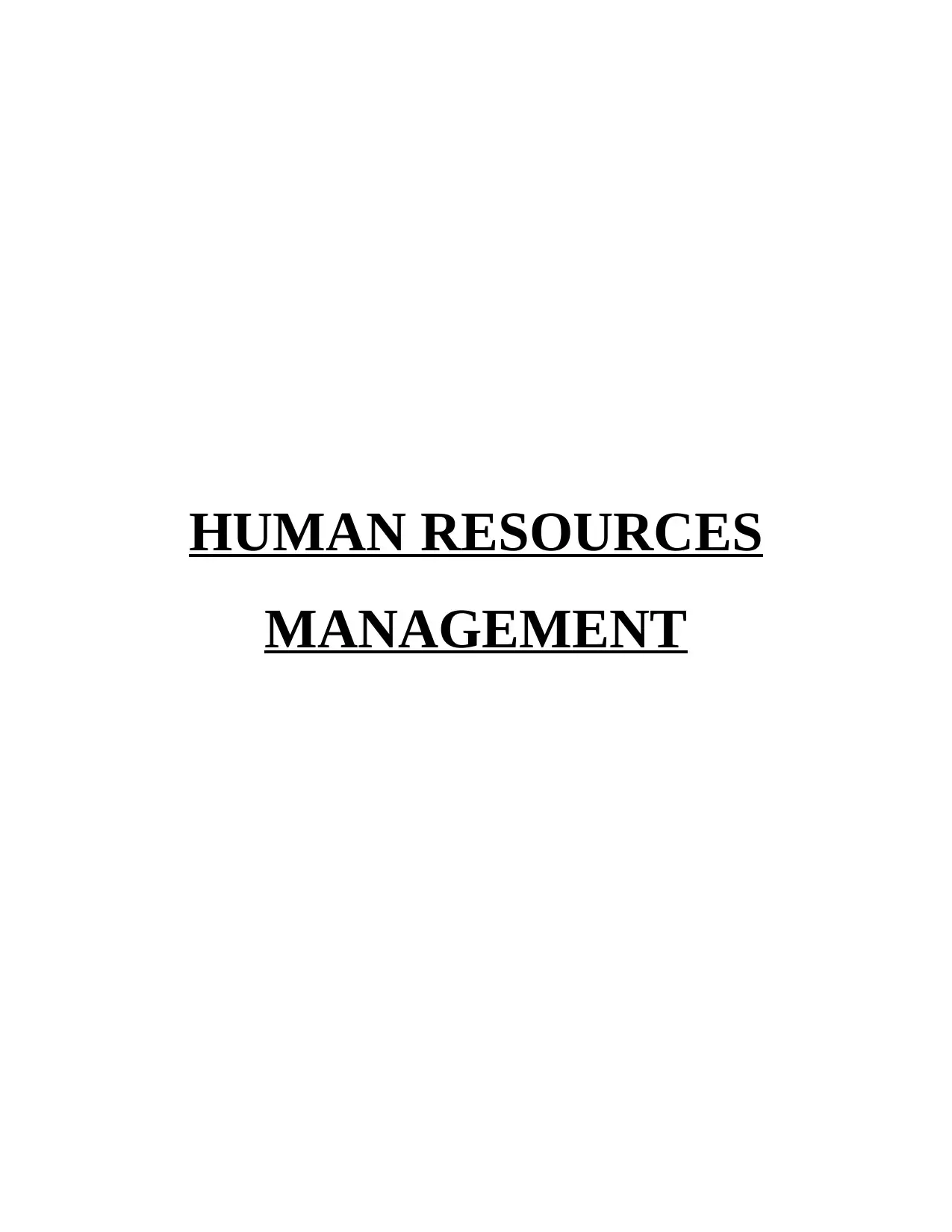
HUMAN RESOURCES
MANAGEMENT
MANAGEMENT
Paraphrase This Document
Need a fresh take? Get an instant paraphrase of this document with our AI Paraphraser
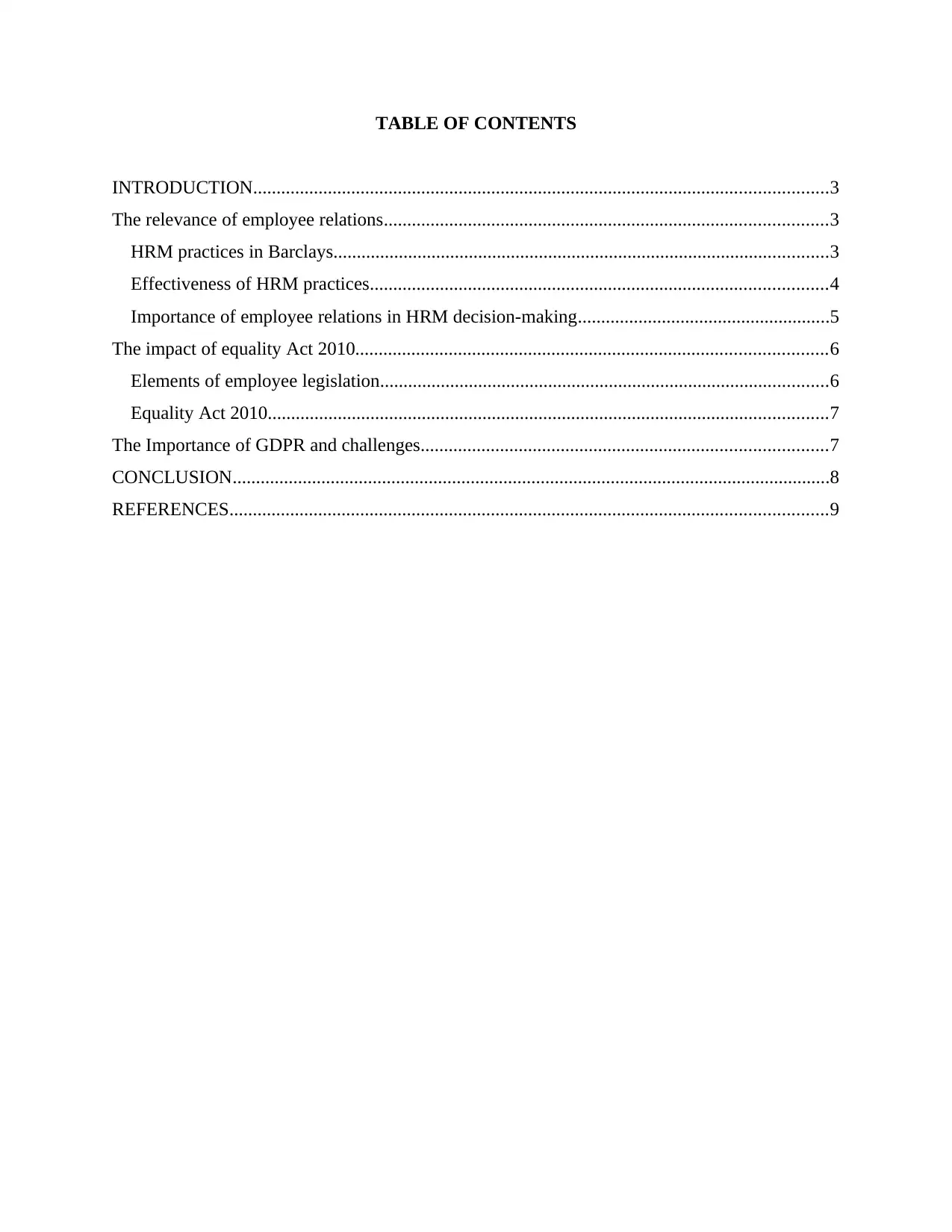
TABLE OF CONTENTS
INTRODUCTION...........................................................................................................................3
The relevance of employee relations...............................................................................................3
HRM practices in Barclays..........................................................................................................3
Effectiveness of HRM practices..................................................................................................4
Importance of employee relations in HRM decision-making......................................................5
The impact of equality Act 2010.....................................................................................................6
Elements of employee legislation................................................................................................6
Equality Act 2010........................................................................................................................7
The Importance of GDPR and challenges.......................................................................................7
CONCLUSION................................................................................................................................8
REFERENCES................................................................................................................................9
INTRODUCTION...........................................................................................................................3
The relevance of employee relations...............................................................................................3
HRM practices in Barclays..........................................................................................................3
Effectiveness of HRM practices..................................................................................................4
Importance of employee relations in HRM decision-making......................................................5
The impact of equality Act 2010.....................................................................................................6
Elements of employee legislation................................................................................................6
Equality Act 2010........................................................................................................................7
The Importance of GDPR and challenges.......................................................................................7
CONCLUSION................................................................................................................................8
REFERENCES................................................................................................................................9
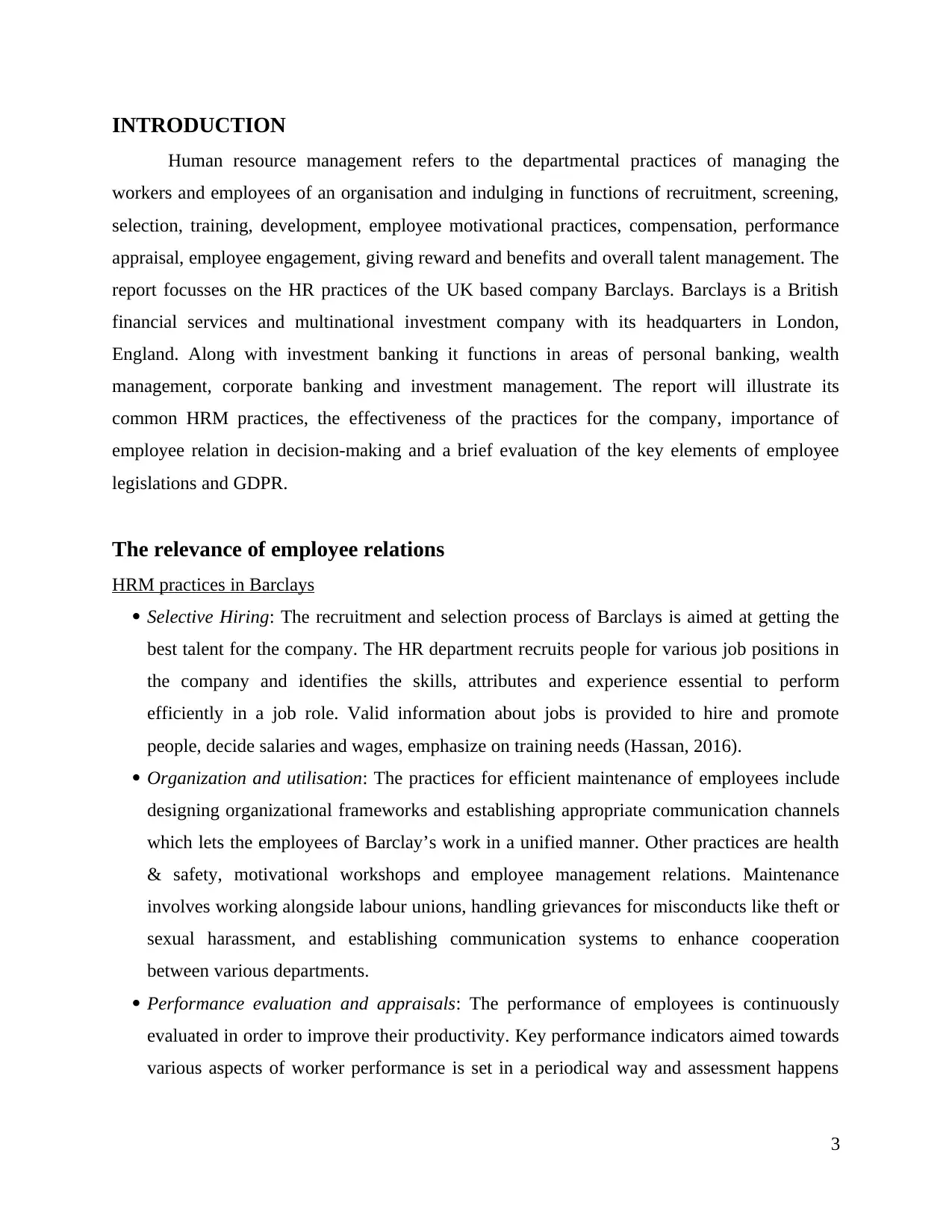
INTRODUCTION
Human resource management refers to the departmental practices of managing the
workers and employees of an organisation and indulging in functions of recruitment, screening,
selection, training, development, employee motivational practices, compensation, performance
appraisal, employee engagement, giving reward and benefits and overall talent management. The
report focusses on the HR practices of the UK based company Barclays. Barclays is a British
financial services and multinational investment company with its headquarters in London,
England. Along with investment banking it functions in areas of personal banking, wealth
management, corporate banking and investment management. The report will illustrate its
common HRM practices, the effectiveness of the practices for the company, importance of
employee relation in decision-making and a brief evaluation of the key elements of employee
legislations and GDPR.
The relevance of employee relations
HRM practices in Barclays
Selective Hiring: The recruitment and selection process of Barclays is aimed at getting the
best talent for the company. The HR department recruits people for various job positions in
the company and identifies the skills, attributes and experience essential to perform
efficiently in a job role. Valid information about jobs is provided to hire and promote
people, decide salaries and wages, emphasize on training needs (Hassan, 2016).
Organization and utilisation: The practices for efficient maintenance of employees include
designing organizational frameworks and establishing appropriate communication channels
which lets the employees of Barclay’s work in a unified manner. Other practices are health
& safety, motivational workshops and employee management relations. Maintenance
involves working alongside labour unions, handling grievances for misconducts like theft or
sexual harassment, and establishing communication systems to enhance cooperation
between various departments.
Performance evaluation and appraisals: The performance of employees is continuously
evaluated in order to improve their productivity. Key performance indicators aimed towards
various aspects of worker performance is set in a periodical way and assessment happens
3
Human resource management refers to the departmental practices of managing the
workers and employees of an organisation and indulging in functions of recruitment, screening,
selection, training, development, employee motivational practices, compensation, performance
appraisal, employee engagement, giving reward and benefits and overall talent management. The
report focusses on the HR practices of the UK based company Barclays. Barclays is a British
financial services and multinational investment company with its headquarters in London,
England. Along with investment banking it functions in areas of personal banking, wealth
management, corporate banking and investment management. The report will illustrate its
common HRM practices, the effectiveness of the practices for the company, importance of
employee relation in decision-making and a brief evaluation of the key elements of employee
legislations and GDPR.
The relevance of employee relations
HRM practices in Barclays
Selective Hiring: The recruitment and selection process of Barclays is aimed at getting the
best talent for the company. The HR department recruits people for various job positions in
the company and identifies the skills, attributes and experience essential to perform
efficiently in a job role. Valid information about jobs is provided to hire and promote
people, decide salaries and wages, emphasize on training needs (Hassan, 2016).
Organization and utilisation: The practices for efficient maintenance of employees include
designing organizational frameworks and establishing appropriate communication channels
which lets the employees of Barclay’s work in a unified manner. Other practices are health
& safety, motivational workshops and employee management relations. Maintenance
involves working alongside labour unions, handling grievances for misconducts like theft or
sexual harassment, and establishing communication systems to enhance cooperation
between various departments.
Performance evaluation and appraisals: The performance of employees is continuously
evaluated in order to improve their productivity. Key performance indicators aimed towards
various aspects of worker performance is set in a periodical way and assessment happens
3
⊘ This is a preview!⊘
Do you want full access?
Subscribe today to unlock all pages.

Trusted by 1+ million students worldwide
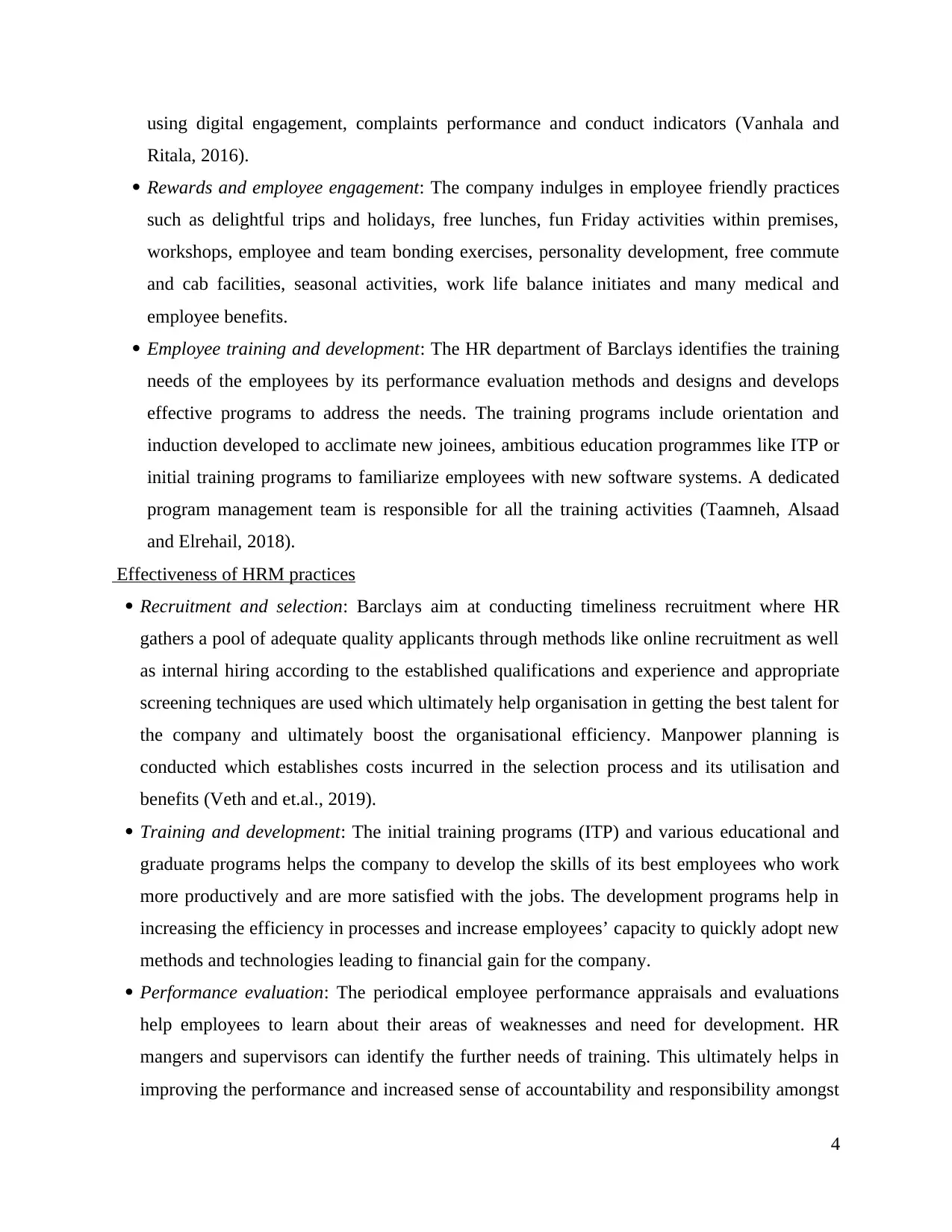
using digital engagement, complaints performance and conduct indicators (Vanhala and
Ritala, 2016).
Rewards and employee engagement: The company indulges in employee friendly practices
such as delightful trips and holidays, free lunches, fun Friday activities within premises,
workshops, employee and team bonding exercises, personality development, free commute
and cab facilities, seasonal activities, work life balance initiates and many medical and
employee benefits.
Employee training and development: The HR department of Barclays identifies the training
needs of the employees by its performance evaluation methods and designs and develops
effective programs to address the needs. The training programs include orientation and
induction developed to acclimate new joinees, ambitious education programmes like ITP or
initial training programs to familiarize employees with new software systems. A dedicated
program management team is responsible for all the training activities (Taamneh, Alsaad
and Elrehail, 2018).
Effectiveness of HRM practices
Recruitment and selection: Barclays aim at conducting timeliness recruitment where HR
gathers a pool of adequate quality applicants through methods like online recruitment as well
as internal hiring according to the established qualifications and experience and appropriate
screening techniques are used which ultimately help organisation in getting the best talent for
the company and ultimately boost the organisational efficiency. Manpower planning is
conducted which establishes costs incurred in the selection process and its utilisation and
benefits (Veth and et.al., 2019).
Training and development: The initial training programs (ITP) and various educational and
graduate programs helps the company to develop the skills of its best employees who work
more productively and are more satisfied with the jobs. The development programs help in
increasing the efficiency in processes and increase employees’ capacity to quickly adopt new
methods and technologies leading to financial gain for the company.
Performance evaluation: The periodical employee performance appraisals and evaluations
help employees to learn about their areas of weaknesses and need for development. HR
mangers and supervisors can identify the further needs of training. This ultimately helps in
improving the performance and increased sense of accountability and responsibility amongst
4
Ritala, 2016).
Rewards and employee engagement: The company indulges in employee friendly practices
such as delightful trips and holidays, free lunches, fun Friday activities within premises,
workshops, employee and team bonding exercises, personality development, free commute
and cab facilities, seasonal activities, work life balance initiates and many medical and
employee benefits.
Employee training and development: The HR department of Barclays identifies the training
needs of the employees by its performance evaluation methods and designs and develops
effective programs to address the needs. The training programs include orientation and
induction developed to acclimate new joinees, ambitious education programmes like ITP or
initial training programs to familiarize employees with new software systems. A dedicated
program management team is responsible for all the training activities (Taamneh, Alsaad
and Elrehail, 2018).
Effectiveness of HRM practices
Recruitment and selection: Barclays aim at conducting timeliness recruitment where HR
gathers a pool of adequate quality applicants through methods like online recruitment as well
as internal hiring according to the established qualifications and experience and appropriate
screening techniques are used which ultimately help organisation in getting the best talent for
the company and ultimately boost the organisational efficiency. Manpower planning is
conducted which establishes costs incurred in the selection process and its utilisation and
benefits (Veth and et.al., 2019).
Training and development: The initial training programs (ITP) and various educational and
graduate programs helps the company to develop the skills of its best employees who work
more productively and are more satisfied with the jobs. The development programs help in
increasing the efficiency in processes and increase employees’ capacity to quickly adopt new
methods and technologies leading to financial gain for the company.
Performance evaluation: The periodical employee performance appraisals and evaluations
help employees to learn about their areas of weaknesses and need for development. HR
mangers and supervisors can identify the further needs of training. This ultimately helps in
improving the performance and increased sense of accountability and responsibility amongst
4
Paraphrase This Document
Need a fresh take? Get an instant paraphrase of this document with our AI Paraphraser
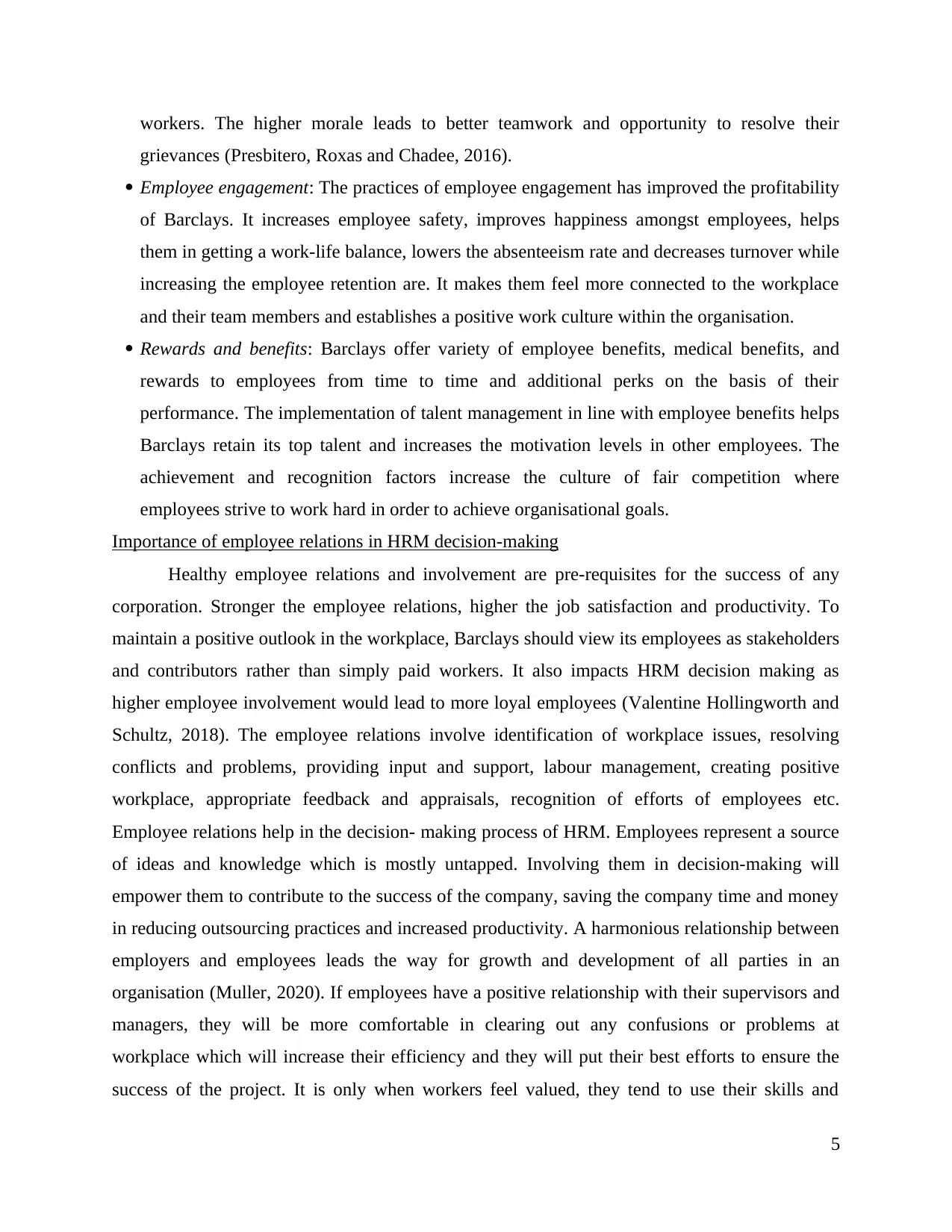
workers. The higher morale leads to better teamwork and opportunity to resolve their
grievances (Presbitero, Roxas and Chadee, 2016).
Employee engagement: The practices of employee engagement has improved the profitability
of Barclays. It increases employee safety, improves happiness amongst employees, helps
them in getting a work-life balance, lowers the absenteeism rate and decreases turnover while
increasing the employee retention are. It makes them feel more connected to the workplace
and their team members and establishes a positive work culture within the organisation.
Rewards and benefits: Barclays offer variety of employee benefits, medical benefits, and
rewards to employees from time to time and additional perks on the basis of their
performance. The implementation of talent management in line with employee benefits helps
Barclays retain its top talent and increases the motivation levels in other employees. The
achievement and recognition factors increase the culture of fair competition where
employees strive to work hard in order to achieve organisational goals.
Importance of employee relations in HRM decision-making
Healthy employee relations and involvement are pre-requisites for the success of any
corporation. Stronger the employee relations, higher the job satisfaction and productivity. To
maintain a positive outlook in the workplace, Barclays should view its employees as stakeholders
and contributors rather than simply paid workers. It also impacts HRM decision making as
higher employee involvement would lead to more loyal employees (Valentine Hollingworth and
Schultz, 2018). The employee relations involve identification of workplace issues, resolving
conflicts and problems, providing input and support, labour management, creating positive
workplace, appropriate feedback and appraisals, recognition of efforts of employees etc.
Employee relations help in the decision- making process of HRM. Employees represent a source
of ideas and knowledge which is mostly untapped. Involving them in decision-making will
empower them to contribute to the success of the company, saving the company time and money
in reducing outsourcing practices and increased productivity. A harmonious relationship between
employers and employees leads the way for growth and development of all parties in an
organisation (Muller, 2020). If employees have a positive relationship with their supervisors and
managers, they will be more comfortable in clearing out any confusions or problems at
workplace which will increase their efficiency and they will put their best efforts to ensure the
success of the project. It is only when workers feel valued, they tend to use their skills and
5
grievances (Presbitero, Roxas and Chadee, 2016).
Employee engagement: The practices of employee engagement has improved the profitability
of Barclays. It increases employee safety, improves happiness amongst employees, helps
them in getting a work-life balance, lowers the absenteeism rate and decreases turnover while
increasing the employee retention are. It makes them feel more connected to the workplace
and their team members and establishes a positive work culture within the organisation.
Rewards and benefits: Barclays offer variety of employee benefits, medical benefits, and
rewards to employees from time to time and additional perks on the basis of their
performance. The implementation of talent management in line with employee benefits helps
Barclays retain its top talent and increases the motivation levels in other employees. The
achievement and recognition factors increase the culture of fair competition where
employees strive to work hard in order to achieve organisational goals.
Importance of employee relations in HRM decision-making
Healthy employee relations and involvement are pre-requisites for the success of any
corporation. Stronger the employee relations, higher the job satisfaction and productivity. To
maintain a positive outlook in the workplace, Barclays should view its employees as stakeholders
and contributors rather than simply paid workers. It also impacts HRM decision making as
higher employee involvement would lead to more loyal employees (Valentine Hollingworth and
Schultz, 2018). The employee relations involve identification of workplace issues, resolving
conflicts and problems, providing input and support, labour management, creating positive
workplace, appropriate feedback and appraisals, recognition of efforts of employees etc.
Employee relations help in the decision- making process of HRM. Employees represent a source
of ideas and knowledge which is mostly untapped. Involving them in decision-making will
empower them to contribute to the success of the company, saving the company time and money
in reducing outsourcing practices and increased productivity. A harmonious relationship between
employers and employees leads the way for growth and development of all parties in an
organisation (Muller, 2020). If employees have a positive relationship with their supervisors and
managers, they will be more comfortable in clearing out any confusions or problems at
workplace which will increase their efficiency and they will put their best efforts to ensure the
success of the project. It is only when workers feel valued, they tend to use their skills and
5
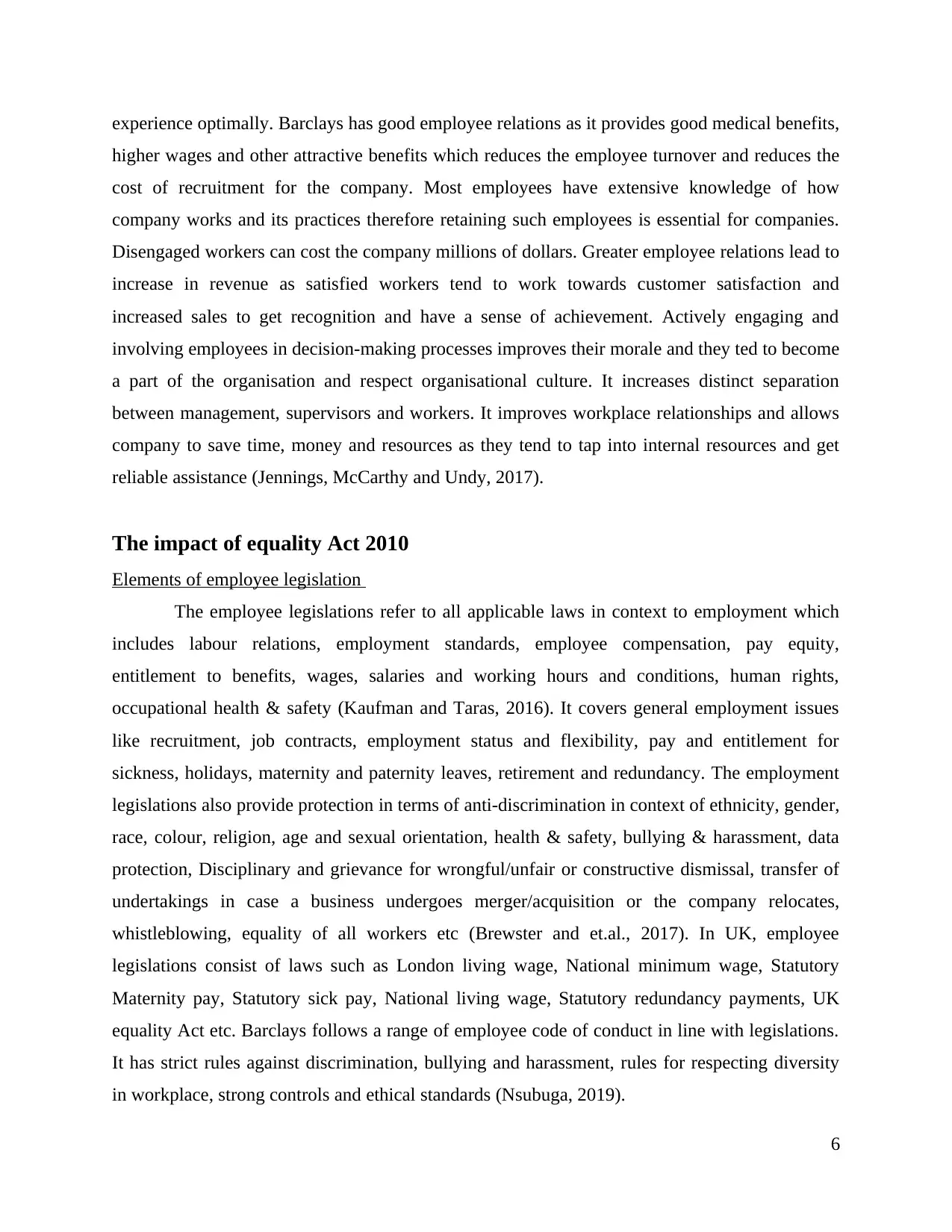
experience optimally. Barclays has good employee relations as it provides good medical benefits,
higher wages and other attractive benefits which reduces the employee turnover and reduces the
cost of recruitment for the company. Most employees have extensive knowledge of how
company works and its practices therefore retaining such employees is essential for companies.
Disengaged workers can cost the company millions of dollars. Greater employee relations lead to
increase in revenue as satisfied workers tend to work towards customer satisfaction and
increased sales to get recognition and have a sense of achievement. Actively engaging and
involving employees in decision-making processes improves their morale and they ted to become
a part of the organisation and respect organisational culture. It increases distinct separation
between management, supervisors and workers. It improves workplace relationships and allows
company to save time, money and resources as they tend to tap into internal resources and get
reliable assistance (Jennings, McCarthy and Undy, 2017).
The impact of equality Act 2010
Elements of employee legislation
The employee legislations refer to all applicable laws in context to employment which
includes labour relations, employment standards, employee compensation, pay equity,
entitlement to benefits, wages, salaries and working hours and conditions, human rights,
occupational health & safety (Kaufman and Taras, 2016). It covers general employment issues
like recruitment, job contracts, employment status and flexibility, pay and entitlement for
sickness, holidays, maternity and paternity leaves, retirement and redundancy. The employment
legislations also provide protection in terms of anti-discrimination in context of ethnicity, gender,
race, colour, religion, age and sexual orientation, health & safety, bullying & harassment, data
protection, Disciplinary and grievance for wrongful/unfair or constructive dismissal, transfer of
undertakings in case a business undergoes merger/acquisition or the company relocates,
whistleblowing, equality of all workers etc (Brewster and et.al., 2017). In UK, employee
legislations consist of laws such as London living wage, National minimum wage, Statutory
Maternity pay, Statutory sick pay, National living wage, Statutory redundancy payments, UK
equality Act etc. Barclays follows a range of employee code of conduct in line with legislations.
It has strict rules against discrimination, bullying and harassment, rules for respecting diversity
in workplace, strong controls and ethical standards (Nsubuga, 2019).
6
higher wages and other attractive benefits which reduces the employee turnover and reduces the
cost of recruitment for the company. Most employees have extensive knowledge of how
company works and its practices therefore retaining such employees is essential for companies.
Disengaged workers can cost the company millions of dollars. Greater employee relations lead to
increase in revenue as satisfied workers tend to work towards customer satisfaction and
increased sales to get recognition and have a sense of achievement. Actively engaging and
involving employees in decision-making processes improves their morale and they ted to become
a part of the organisation and respect organisational culture. It increases distinct separation
between management, supervisors and workers. It improves workplace relationships and allows
company to save time, money and resources as they tend to tap into internal resources and get
reliable assistance (Jennings, McCarthy and Undy, 2017).
The impact of equality Act 2010
Elements of employee legislation
The employee legislations refer to all applicable laws in context to employment which
includes labour relations, employment standards, employee compensation, pay equity,
entitlement to benefits, wages, salaries and working hours and conditions, human rights,
occupational health & safety (Kaufman and Taras, 2016). It covers general employment issues
like recruitment, job contracts, employment status and flexibility, pay and entitlement for
sickness, holidays, maternity and paternity leaves, retirement and redundancy. The employment
legislations also provide protection in terms of anti-discrimination in context of ethnicity, gender,
race, colour, religion, age and sexual orientation, health & safety, bullying & harassment, data
protection, Disciplinary and grievance for wrongful/unfair or constructive dismissal, transfer of
undertakings in case a business undergoes merger/acquisition or the company relocates,
whistleblowing, equality of all workers etc (Brewster and et.al., 2017). In UK, employee
legislations consist of laws such as London living wage, National minimum wage, Statutory
Maternity pay, Statutory sick pay, National living wage, Statutory redundancy payments, UK
equality Act etc. Barclays follows a range of employee code of conduct in line with legislations.
It has strict rules against discrimination, bullying and harassment, rules for respecting diversity
in workplace, strong controls and ethical standards (Nsubuga, 2019).
6
⊘ This is a preview!⊘
Do you want full access?
Subscribe today to unlock all pages.

Trusted by 1+ million students worldwide
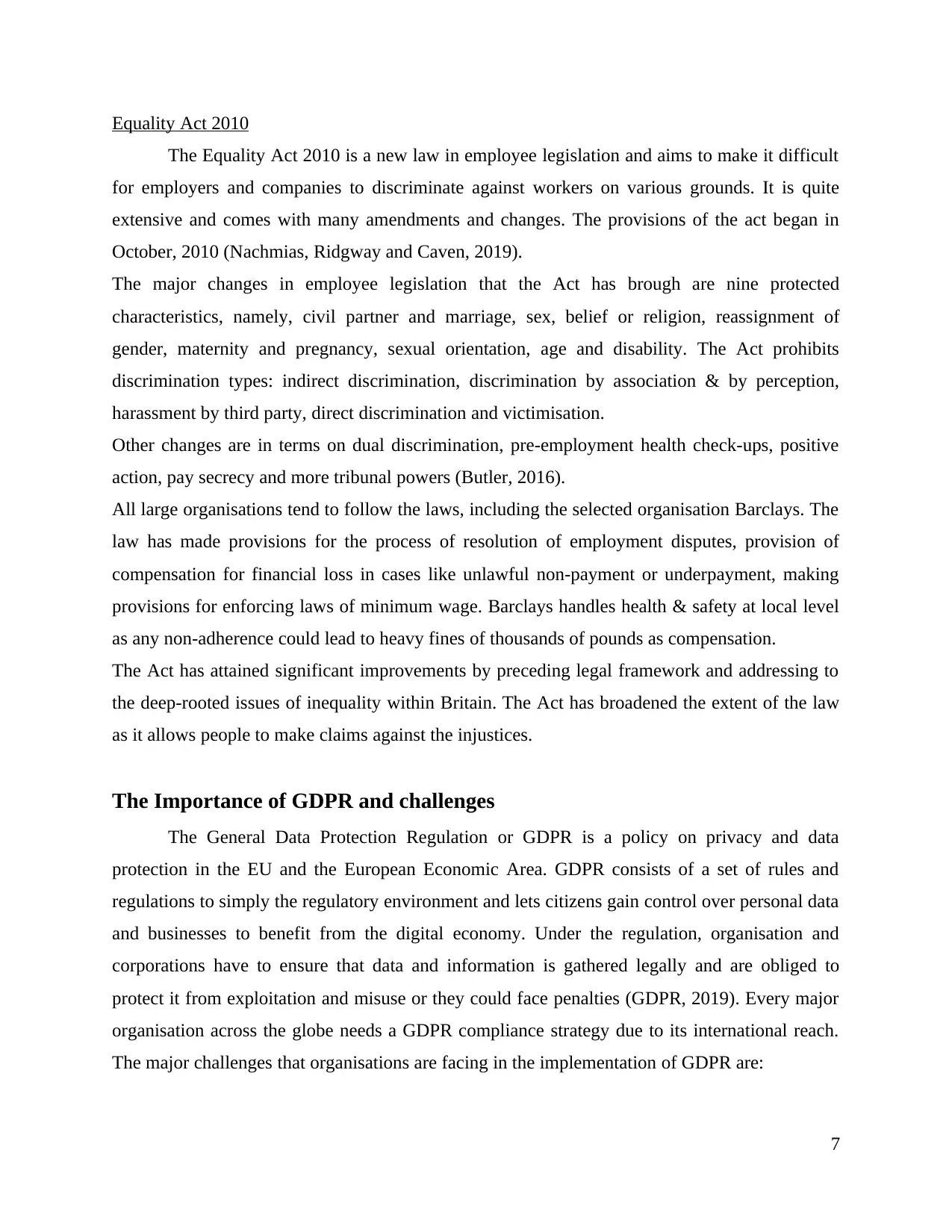
Equality Act 2010
The Equality Act 2010 is a new law in employee legislation and aims to make it difficult
for employers and companies to discriminate against workers on various grounds. It is quite
extensive and comes with many amendments and changes. The provisions of the act began in
October, 2010 (Nachmias, Ridgway and Caven, 2019).
The major changes in employee legislation that the Act has brough are nine protected
characteristics, namely, civil partner and marriage, sex, belief or religion, reassignment of
gender, maternity and pregnancy, sexual orientation, age and disability. The Act prohibits
discrimination types: indirect discrimination, discrimination by association & by perception,
harassment by third party, direct discrimination and victimisation.
Other changes are in terms on dual discrimination, pre-employment health check-ups, positive
action, pay secrecy and more tribunal powers (Butler, 2016).
All large organisations tend to follow the laws, including the selected organisation Barclays. The
law has made provisions for the process of resolution of employment disputes, provision of
compensation for financial loss in cases like unlawful non-payment or underpayment, making
provisions for enforcing laws of minimum wage. Barclays handles health & safety at local level
as any non-adherence could lead to heavy fines of thousands of pounds as compensation.
The Act has attained significant improvements by preceding legal framework and addressing to
the deep-rooted issues of inequality within Britain. The Act has broadened the extent of the law
as it allows people to make claims against the injustices.
The Importance of GDPR and challenges
The General Data Protection Regulation or GDPR is a policy on privacy and data
protection in the EU and the European Economic Area. GDPR consists of a set of rules and
regulations to simply the regulatory environment and lets citizens gain control over personal data
and businesses to benefit from the digital economy. Under the regulation, organisation and
corporations have to ensure that data and information is gathered legally and are obliged to
protect it from exploitation and misuse or they could face penalties (GDPR, 2019). Every major
organisation across the globe needs a GDPR compliance strategy due to its international reach.
The major challenges that organisations are facing in the implementation of GDPR are:
7
The Equality Act 2010 is a new law in employee legislation and aims to make it difficult
for employers and companies to discriminate against workers on various grounds. It is quite
extensive and comes with many amendments and changes. The provisions of the act began in
October, 2010 (Nachmias, Ridgway and Caven, 2019).
The major changes in employee legislation that the Act has brough are nine protected
characteristics, namely, civil partner and marriage, sex, belief or religion, reassignment of
gender, maternity and pregnancy, sexual orientation, age and disability. The Act prohibits
discrimination types: indirect discrimination, discrimination by association & by perception,
harassment by third party, direct discrimination and victimisation.
Other changes are in terms on dual discrimination, pre-employment health check-ups, positive
action, pay secrecy and more tribunal powers (Butler, 2016).
All large organisations tend to follow the laws, including the selected organisation Barclays. The
law has made provisions for the process of resolution of employment disputes, provision of
compensation for financial loss in cases like unlawful non-payment or underpayment, making
provisions for enforcing laws of minimum wage. Barclays handles health & safety at local level
as any non-adherence could lead to heavy fines of thousands of pounds as compensation.
The Act has attained significant improvements by preceding legal framework and addressing to
the deep-rooted issues of inequality within Britain. The Act has broadened the extent of the law
as it allows people to make claims against the injustices.
The Importance of GDPR and challenges
The General Data Protection Regulation or GDPR is a policy on privacy and data
protection in the EU and the European Economic Area. GDPR consists of a set of rules and
regulations to simply the regulatory environment and lets citizens gain control over personal data
and businesses to benefit from the digital economy. Under the regulation, organisation and
corporations have to ensure that data and information is gathered legally and are obliged to
protect it from exploitation and misuse or they could face penalties (GDPR, 2019). Every major
organisation across the globe needs a GDPR compliance strategy due to its international reach.
The major challenges that organisations are facing in the implementation of GDPR are:
7
Paraphrase This Document
Need a fresh take? Get an instant paraphrase of this document with our AI Paraphraser
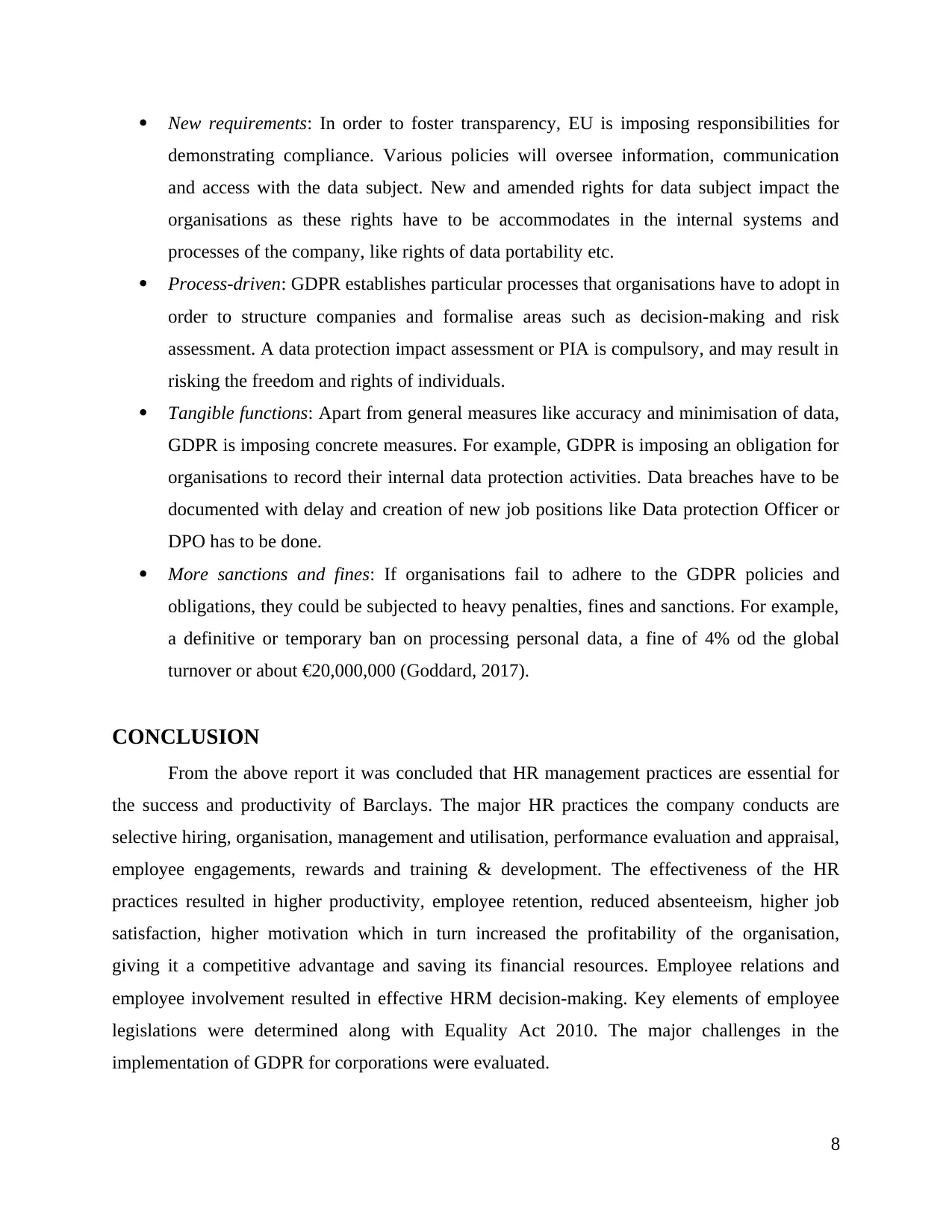
New requirements: In order to foster transparency, EU is imposing responsibilities for
demonstrating compliance. Various policies will oversee information, communication
and access with the data subject. New and amended rights for data subject impact the
organisations as these rights have to be accommodates in the internal systems and
processes of the company, like rights of data portability etc.
Process-driven: GDPR establishes particular processes that organisations have to adopt in
order to structure companies and formalise areas such as decision-making and risk
assessment. A data protection impact assessment or PIA is compulsory, and may result in
risking the freedom and rights of individuals.
Tangible functions: Apart from general measures like accuracy and minimisation of data,
GDPR is imposing concrete measures. For example, GDPR is imposing an obligation for
organisations to record their internal data protection activities. Data breaches have to be
documented with delay and creation of new job positions like Data protection Officer or
DPO has to be done.
More sanctions and fines: If organisations fail to adhere to the GDPR policies and
obligations, they could be subjected to heavy penalties, fines and sanctions. For example,
a definitive or temporary ban on processing personal data, a fine of 4% od the global
turnover or about €20,000,000 (Goddard, 2017).
CONCLUSION
From the above report it was concluded that HR management practices are essential for
the success and productivity of Barclays. The major HR practices the company conducts are
selective hiring, organisation, management and utilisation, performance evaluation and appraisal,
employee engagements, rewards and training & development. The effectiveness of the HR
practices resulted in higher productivity, employee retention, reduced absenteeism, higher job
satisfaction, higher motivation which in turn increased the profitability of the organisation,
giving it a competitive advantage and saving its financial resources. Employee relations and
employee involvement resulted in effective HRM decision-making. Key elements of employee
legislations were determined along with Equality Act 2010. The major challenges in the
implementation of GDPR for corporations were evaluated.
8
demonstrating compliance. Various policies will oversee information, communication
and access with the data subject. New and amended rights for data subject impact the
organisations as these rights have to be accommodates in the internal systems and
processes of the company, like rights of data portability etc.
Process-driven: GDPR establishes particular processes that organisations have to adopt in
order to structure companies and formalise areas such as decision-making and risk
assessment. A data protection impact assessment or PIA is compulsory, and may result in
risking the freedom and rights of individuals.
Tangible functions: Apart from general measures like accuracy and minimisation of data,
GDPR is imposing concrete measures. For example, GDPR is imposing an obligation for
organisations to record their internal data protection activities. Data breaches have to be
documented with delay and creation of new job positions like Data protection Officer or
DPO has to be done.
More sanctions and fines: If organisations fail to adhere to the GDPR policies and
obligations, they could be subjected to heavy penalties, fines and sanctions. For example,
a definitive or temporary ban on processing personal data, a fine of 4% od the global
turnover or about €20,000,000 (Goddard, 2017).
CONCLUSION
From the above report it was concluded that HR management practices are essential for
the success and productivity of Barclays. The major HR practices the company conducts are
selective hiring, organisation, management and utilisation, performance evaluation and appraisal,
employee engagements, rewards and training & development. The effectiveness of the HR
practices resulted in higher productivity, employee retention, reduced absenteeism, higher job
satisfaction, higher motivation which in turn increased the profitability of the organisation,
giving it a competitive advantage and saving its financial resources. Employee relations and
employee involvement resulted in effective HRM decision-making. Key elements of employee
legislations were determined along with Equality Act 2010. The major challenges in the
implementation of GDPR for corporations were evaluated.
8
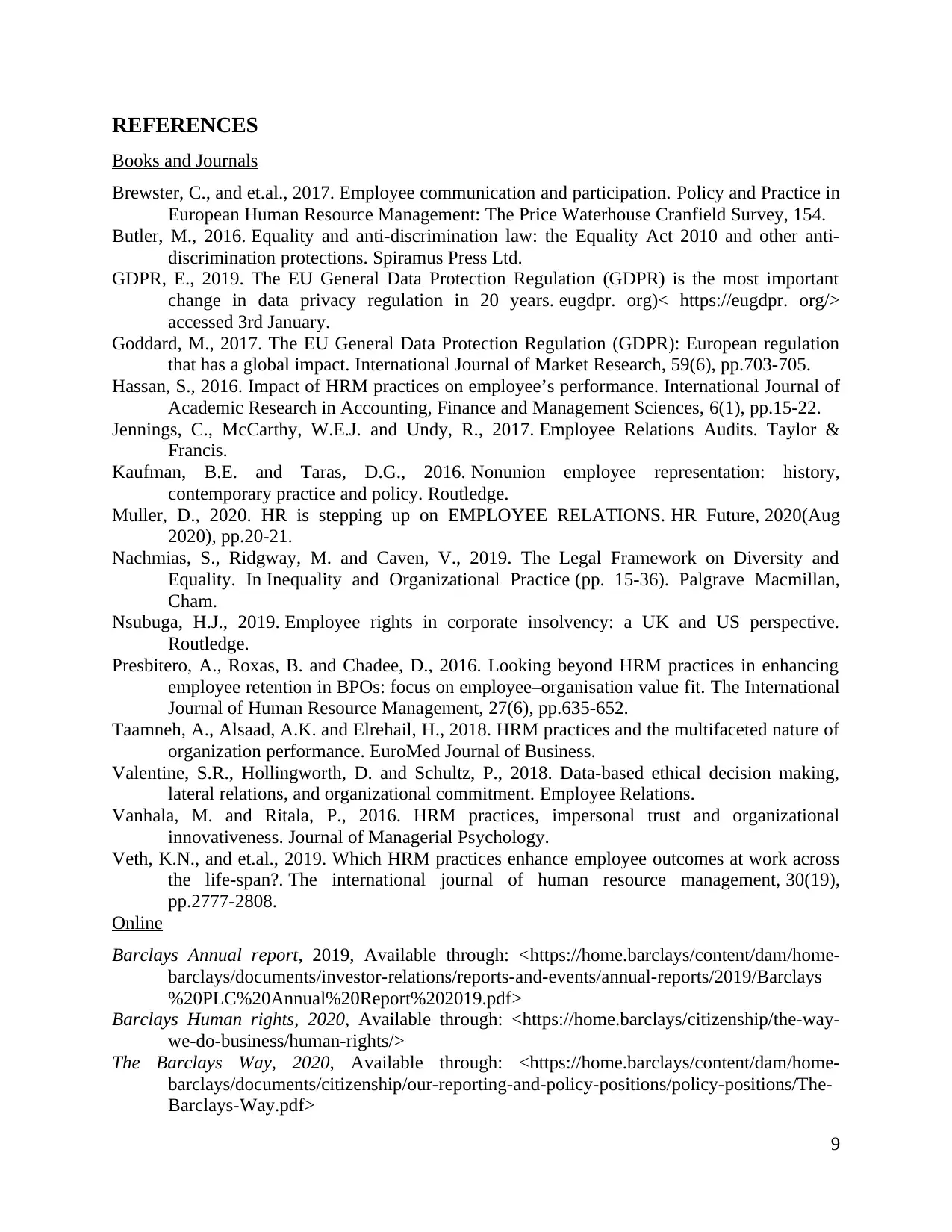
REFERENCES
Books and Journals
Brewster, C., and et.al., 2017. Employee communication and participation. Policy and Practice in
European Human Resource Management: The Price Waterhouse Cranfield Survey, 154.
Butler, M., 2016. Equality and anti-discrimination law: the Equality Act 2010 and other anti-
discrimination protections. Spiramus Press Ltd.
GDPR, E., 2019. The EU General Data Protection Regulation (GDPR) is the most important
change in data privacy regulation in 20 years. eugdpr. org)< https://eugdpr. org/>
accessed 3rd January.
Goddard, M., 2017. The EU General Data Protection Regulation (GDPR): European regulation
that has a global impact. International Journal of Market Research, 59(6), pp.703-705.
Hassan, S., 2016. Impact of HRM practices on employee’s performance. International Journal of
Academic Research in Accounting, Finance and Management Sciences, 6(1), pp.15-22.
Jennings, C., McCarthy, W.E.J. and Undy, R., 2017. Employee Relations Audits. Taylor &
Francis.
Kaufman, B.E. and Taras, D.G., 2016. Nonunion employee representation: history,
contemporary practice and policy. Routledge.
Muller, D., 2020. HR is stepping up on EMPLOYEE RELATIONS. HR Future, 2020(Aug
2020), pp.20-21.
Nachmias, S., Ridgway, M. and Caven, V., 2019. The Legal Framework on Diversity and
Equality. In Inequality and Organizational Practice (pp. 15-36). Palgrave Macmillan,
Cham.
Nsubuga, H.J., 2019. Employee rights in corporate insolvency: a UK and US perspective.
Routledge.
Presbitero, A., Roxas, B. and Chadee, D., 2016. Looking beyond HRM practices in enhancing
employee retention in BPOs: focus on employee–organisation value fit. The International
Journal of Human Resource Management, 27(6), pp.635-652.
Taamneh, A., Alsaad, A.K. and Elrehail, H., 2018. HRM practices and the multifaceted nature of
organization performance. EuroMed Journal of Business.
Valentine, S.R., Hollingworth, D. and Schultz, P., 2018. Data-based ethical decision making,
lateral relations, and organizational commitment. Employee Relations.
Vanhala, M. and Ritala, P., 2016. HRM practices, impersonal trust and organizational
innovativeness. Journal of Managerial Psychology.
Veth, K.N., and et.al., 2019. Which HRM practices enhance employee outcomes at work across
the life-span?. The international journal of human resource management, 30(19),
pp.2777-2808.
Online
Barclays Annual report, 2019, Available through: <https://home.barclays/content/dam/home-
barclays/documents/investor-relations/reports-and-events/annual-reports/2019/Barclays
%20PLC%20Annual%20Report%202019.pdf>
Barclays Human rights, 2020, Available through: <https://home.barclays/citizenship/the-way-
we-do-business/human-rights/>
The Barclays Way, 2020, Available through: <https://home.barclays/content/dam/home-
barclays/documents/citizenship/our-reporting-and-policy-positions/policy-positions/The-
Barclays-Way.pdf>
9
Books and Journals
Brewster, C., and et.al., 2017. Employee communication and participation. Policy and Practice in
European Human Resource Management: The Price Waterhouse Cranfield Survey, 154.
Butler, M., 2016. Equality and anti-discrimination law: the Equality Act 2010 and other anti-
discrimination protections. Spiramus Press Ltd.
GDPR, E., 2019. The EU General Data Protection Regulation (GDPR) is the most important
change in data privacy regulation in 20 years. eugdpr. org)< https://eugdpr. org/>
accessed 3rd January.
Goddard, M., 2017. The EU General Data Protection Regulation (GDPR): European regulation
that has a global impact. International Journal of Market Research, 59(6), pp.703-705.
Hassan, S., 2016. Impact of HRM practices on employee’s performance. International Journal of
Academic Research in Accounting, Finance and Management Sciences, 6(1), pp.15-22.
Jennings, C., McCarthy, W.E.J. and Undy, R., 2017. Employee Relations Audits. Taylor &
Francis.
Kaufman, B.E. and Taras, D.G., 2016. Nonunion employee representation: history,
contemporary practice and policy. Routledge.
Muller, D., 2020. HR is stepping up on EMPLOYEE RELATIONS. HR Future, 2020(Aug
2020), pp.20-21.
Nachmias, S., Ridgway, M. and Caven, V., 2019. The Legal Framework on Diversity and
Equality. In Inequality and Organizational Practice (pp. 15-36). Palgrave Macmillan,
Cham.
Nsubuga, H.J., 2019. Employee rights in corporate insolvency: a UK and US perspective.
Routledge.
Presbitero, A., Roxas, B. and Chadee, D., 2016. Looking beyond HRM practices in enhancing
employee retention in BPOs: focus on employee–organisation value fit. The International
Journal of Human Resource Management, 27(6), pp.635-652.
Taamneh, A., Alsaad, A.K. and Elrehail, H., 2018. HRM practices and the multifaceted nature of
organization performance. EuroMed Journal of Business.
Valentine, S.R., Hollingworth, D. and Schultz, P., 2018. Data-based ethical decision making,
lateral relations, and organizational commitment. Employee Relations.
Vanhala, M. and Ritala, P., 2016. HRM practices, impersonal trust and organizational
innovativeness. Journal of Managerial Psychology.
Veth, K.N., and et.al., 2019. Which HRM practices enhance employee outcomes at work across
the life-span?. The international journal of human resource management, 30(19),
pp.2777-2808.
Online
Barclays Annual report, 2019, Available through: <https://home.barclays/content/dam/home-
barclays/documents/investor-relations/reports-and-events/annual-reports/2019/Barclays
%20PLC%20Annual%20Report%202019.pdf>
Barclays Human rights, 2020, Available through: <https://home.barclays/citizenship/the-way-
we-do-business/human-rights/>
The Barclays Way, 2020, Available through: <https://home.barclays/content/dam/home-
barclays/documents/citizenship/our-reporting-and-policy-positions/policy-positions/The-
Barclays-Way.pdf>
9
⊘ This is a preview!⊘
Do you want full access?
Subscribe today to unlock all pages.

Trusted by 1+ million students worldwide
1 out of 9
Related Documents
Your All-in-One AI-Powered Toolkit for Academic Success.
+13062052269
info@desklib.com
Available 24*7 on WhatsApp / Email
![[object Object]](/_next/static/media/star-bottom.7253800d.svg)
Unlock your academic potential
Copyright © 2020–2025 A2Z Services. All Rights Reserved. Developed and managed by ZUCOL.





